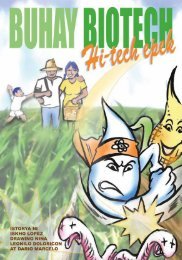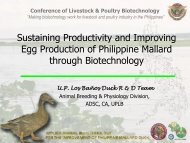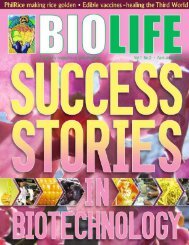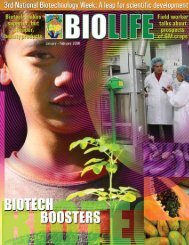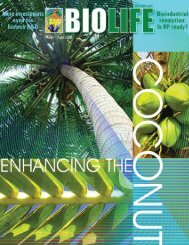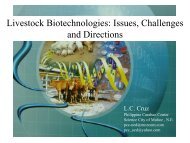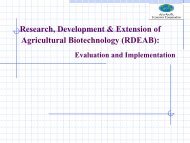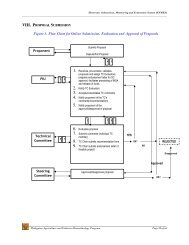Download PDF - SEARCA Biotechnology Information Center
Download PDF - SEARCA Biotechnology Information Center
Download PDF - SEARCA Biotechnology Information Center
You also want an ePaper? Increase the reach of your titles
YUMPU automatically turns print PDFs into web optimized ePapers that Google loves.
January – March 2005 BIO LIFE<br />
19<br />
Table 5. Welfare Effects of Bt corn Adoption,<br />
by location, Philippines, 2003-2004<br />
Northern Southern Northern Southern All<br />
Item Luzon Luzon Mindanao Mindanao Locations<br />
Area (hect ares)a 7, 901 2,257 130 481 10,769<br />
Yield/ha (kg) 5, 304 4,516 4,215 4,794 4,850<br />
Price (PhP/ kg) 8.68 8.00 8.33 8.11 8.82<br />
Cost reduction<br />
(PhP/ kg) 0.50 0.24 (0.68) 0.31 0.23<br />
Net Benefit to<br />
Farmers (million P)b 20. 95 2.45 (0.37) 0.71 46.44<br />
Estimated Gross<br />
Revenue to Seed<br />
Companies (million P) 30. 61 10.16 0.62 2.09 43.48<br />
a Estimates provided by Monsanto, Philippines.<br />
b Taken from Appendix Table 1.<br />
Source of data: ISAAA Corn Survey, 2003-2004<br />
Table 6. Selected characteristics of farming households,<br />
Bt Corn Study, Philippines, 2003-2004.<br />
Characteristic Bt Non-Bt All<br />
Farm size (ha) 4.04 2.47 2.82<br />
Corn area (ha) 2.64 1.64 1.86<br />
Planted corn area (ha) 2.32 1.55 1.72<br />
Age (years) 45.38 46.77 46.46<br />
Years of schooling 9.65 7.81 8.22<br />
Income from other sources<br />
(per month) 4,066.79 1,088.56 1,766.58<br />
Membership in farmer organization (%) 47.66 57.02 54.89<br />
Contact with extension worker (%) 91.04 84.89 86.30<br />
Chemical expense (PhP/ha) 267.21 406.52 371.69<br />
Hired labor (Man-days/ha) 51.99 46.98 48.22<br />
Variety used (%) 25 75 100<br />
Source of data: ISAAA Corn Survey, 2003- 2004<br />
tions. The study also showed that although<br />
fewer Bt corn farmers were members of<br />
farmers’ organizations, many of them (91<br />
percent) have frequent contact with extension<br />
workers.<br />
What needs to be done<br />
With the high cost of Bt corn seeds,<br />
Yorobe said findings ways to reduce that cost<br />
will certainly result in a net benefit to farmers.<br />
“The current effects are still minimal<br />
considering an adoption rate of only 1 percent,”<br />
he said. In order to further realize the<br />
benefits of Bt corn through higher adoption<br />
rates, public support is needed in terms of<br />
information dissemination, development of<br />
the Bt corn seed market and the government<br />
incentives to facilitate farmers’ access to the<br />
technology.<br />
He said that the availability of Bt corn<br />
seeds is still limited and domestic seed production<br />
capacity is still low. “As the seed<br />
market is opened to other entrants, the adoption<br />
rate and welfare gains are expected to<br />
increase in the future,” he said.<br />
Despite its current limitations, Yorobe<br />
said that the results of the one-year introduction<br />
of Bt corn to Filipino farmers “clearly<br />
favor the national agenda of increased productivity<br />
and income for small corn farmers.”<br />
But, he asserted, “the adoption level should<br />
be increased.”<br />
Farmers<br />
shifting to<br />
new corn<br />
technologies<br />
WHENEVER farmers find a crop that<br />
offers good income and is more<br />
comfortable to work on than their<br />
existing crop, they would not take so<br />
much time to decide on whether or not<br />
they are going to adopt the new crop.<br />
Chances are that they would<br />
switch to the new crop to make their<br />
lives a little bit more comfortable.<br />
Such is the case in three towns of<br />
Pampanga, particularly in Lubao,<br />
Arayat and Mexico.<br />
Traditionally, almost all farmers in<br />
these towns have been producing rice<br />
and sugarcane. Others are into<br />
banana, mango and eggplant farming.<br />
With fellow farmers in Pampanga<br />
making more profit from Bt (Bacillus<br />
thuringiensis) corn, more and more<br />
farmers in these towns are going into<br />
Bt corn production in order to cut cost<br />
of production, increase yield and<br />
reduce the use of chemical sprays.<br />
Bt corn, a bio-engineered or<br />
genetically modified crop, is resistant<br />
to the Asian corn borer, which can<br />
cause severe yield losses.<br />
One of the farmers who has made<br />
the switch is Carlos “Caloy” G.<br />
Guevarra, who operates a 10-hectare<br />
corn production area in barangay<br />
Anao, Mexico, Pampanga.<br />
Using a Pioneer hybrid 30Y73 with<br />
YieldGard Corn Borer Protection<br />
during the dry season, he was able to<br />
harvest an average yield of a recordhigh<br />
10.25 metric tons (mt)/hectare,<br />
equivalent to 153 cavans.<br />
Guevarra said, “At a price of P7.50<br />
a kilo corn grain, my gross income<br />
reached around P76,000, giving me a<br />
net income of more than P50,000 a<br />
hectare.”<br />
Guevarra likes to use the new<br />
technology even if he does not usually<br />
encounter corn borer problems in his<br />
farm because he claims that farmers<br />
can never really predict when the<br />
insect pest will significantly damage<br />
Turn to page 33




